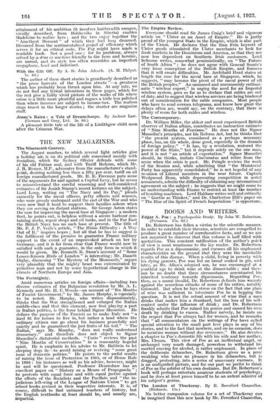The London of Thackeray. By E. 13eresford Chancellor. (Richards. 158.)
The London of Thackeray. By E. 13eresford Chancellor. (Richards. 158.) No better_ companion volume for a set of Thackeray can be imagined than this new book by Mr. Beresford Chancellor, the author of so many excellent books on London. It concerns itself entirely with the topography of Thackeray's novels, and does not describe the novelist's own haunts, which have already been dealt with elsewhere. Here we have the London of Thackeray's characters, and it necessarily follows that what we really get is not just one London but several; from Esmond to The Nezccomes, that is, from the time of Queen Anne to that of Queen Victoria, there is an interval of nearly a century and a-half, years enough to change the face of most cities almost beyond recognition. Mr. Chancellor's method is to take each novel and, setting aside the parts that fall outside the range of the metropolis—and they are really surprisingly few—to trace the topography as the story develops. Where it has been necessary he has indicated the course of the story, and in not a few places he has enriched his text with some particularly well-chosen extracts from Thackeray himself. Unlike Dickens, Thackeray seems to have gone to little pains to disguise the localities he used in his fiction ; beyond changing the name (and even then doing it in a way that leaves the original fairly obvious to the knowledge- able reader), and occasionally altering a square, a street, or a building, to suit his convenience, he appears to have visual- ized the greater part of the action in his novels in definite localities, a habit of his that gives to his work that touch of the concrete and particular which is always so convincing. Mr. Chancellor spares no pains to try and find originals for all the more important thoroughfares and buildings that Thackeray mentions, but, unlike some of the Dickensians, lie does not go to absurd lengths and work on the supposition that his author could not have possibly invented a single street or tavern. Here, then, charmingly illustrated by a number of old prints, is the " London known to the Newcoines and Pendennis • the London where Brand Firmin and the Little Sister had their struggles ; the London of Beatrice Esmond and the wits, of Costigan and the revellers. The Curzon Street we visit is the Curzon Street of Mrs. Rawdon Crawley ; the Russell Square is the Russell Square of the Sedleys and the Osbornes." And the effect of it all upon at least one reader of this volume has been to make him want to sit down immediately and read Thackeray all over again.



































 Previous page
Previous page